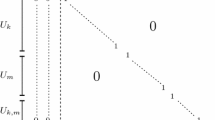Abstract
We formulate and solve a dual version of the Continuous Collapsing Knapsack Problem using a geometric approach. Optimality conditions are found and an algorithm is presented. Computational experience shows that this procedure is efficient.
Similar content being viewed by others
References
M.E. Dyer, “An O(n) algorithm for the multiple choice knapsack problem,”Mathematical Programming 29 (1984) 57–63.
D. Fayard and G. Plateau, “On the collapsing 0–1 knapsack problem,” contributed paper Tenth International Symposium on Mathematical Programming, Montreal (August 1979).
F. Glover and D. Klingman, “An O(n logn) algorithm for LP knapsacks with GUB constraints,”Mathematical Programming 17 (1979) 345–361.
R.L. Graham, “An efficient algorithm for determining the convex hull of a finite planar set,”Information Processing Letters 1 (1972) 132–133.
T. Ibaraki, T. Hasegawa, T. Teranaka and J. Iwase, “The multiple choice knapsack problem,”Journal of the Operations Research Society of Japan 21 (1978) 59–95.
T. Ibaraki, “Approximate algorithms for the multiple choice continuous knapsak problem,”Journal of the Operations Research Society of Japan 23 (1980) 28–63.
M.E. Posner, “The continuous collapsing knapsack problem,”Mathematical Programming 26 (1983) 76–86.
M.E. Posner and M. Guignard, “The 0–1 collapsing knapsack problem,”Mathematical Programming 15 (1978) 155–161.
M.E. Posner and M. Guignard, “The integer collapsing knapsack problem,” Working Paper 80/101, University of Wisconsin-Milwaukee, Milwaukee, WI (1980).
F.P. Preparata and S.J. Hong, “Convex hulls of finite sets of points in two and three dimensions,”Communications of the ACM 20 (1979) 87–93.
L. Schrage, “Implicit representation of generalized variable upper bounds in linear programming,”Mathematical Programming 14 (1978) 11–20.
P. Sinha and A. Zoltners, “The multiple choice knapsack problem,”Operations Research 27 (1979) 503–515.
E. Zemel, “The linear multiple choice knapsack problem,”Operations Research 28 (1980) 1412–1423.
E. Zemel, “An O(n) algorithm for the multiple choice knapsack problem and related problems,”Information Processing Letters 18 (1984) 123–128.
Author information
Authors and Affiliations
Rights and permissions
About this article
Cite this article
Posner, M.E., Suzuki, H. A dual approach for the continuous collapsing knapsack problem. Mathematical Programming 39, 207–214 (1987). https://doi.org/10.1007/BF02592953
Received:
Revised:
Published:
Issue Date:
DOI: https://doi.org/10.1007/BF02592953




